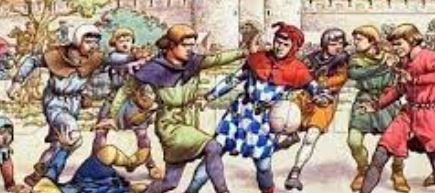La Soule, also known as choule, is a captivating team sport with its origins deeply rooted in the French regions of Normandy and Picardy. This traditional game, which predates many modern sports, is not just a recreational activity but a vital cultural heritage that echoes the communal and festive spirit of medieval Europe.
Origins and Gameplay
The sport of la soule is played with a ball—referred to as a ‘soule’—which could be crafted from wood or leather. Leather balls were typically stuffed with materials like hay, bran, horse hair, or moss, making them robust for play. The game itself naturally evolved as a communal pastime, particularly flourishing during significant gatherings such as after church services or during festivals and weddings.
Played primarily on Christian holidays like Easter and Christmas or during local festivities, la soule involved entire communities. The objective was simple yet physically demanding: teams, often representing different parishes, would compete to bring the ball to a designated landmark, which could be anything from the front of the parish church to a nearby geographical border.
Historical Milestones
1147: A charter in France mentions the transaction involving “seven balloons of greatest dimension,” hinting at the game’s popularity and organized play.[2]
1283: A reference to a tragic incident in Cornwall where a player named Roger fatally injured a fellow player with a stone during a game of soule.[3]
1393: A notable game was played in Paris in front of Saint-Eustache, showcasing the game’s urban appeal.[2]
1396: The game’s rules were formalized, restricting the size of the soules to enhance playability and safety.[2]
1365-1440: Various decrees and prohibitions highlighted the tensions between civil authorities and the game’s traditional role in society.[citation needed]
1841: A massive game in Bellou-en-Houlme drew up to 6,000 spectators, showing the game’s widespread appeal even as it faced official disapproval.[citation needed]
The Evolution of Rules
The rules of la soule were straightforward and broadly adhered to, although they were not codified until much later. Historical records from the 14th century detail the game’s increasing popularity and the subsequent need to standardize aspects of play. For instance, a rule from 1412 mandated that the ball should be small enough to be held with one hand, a regulation that underscores the evolving nature of the game.
Despite the simplicity of its rules, la soule was a rough and tumble game, often leading to injuries among participants. Its aggressive nature was indicative of the social pressures and physical release needed in rural medieval societies.
Cultural Significance and Decline
The game was more than just entertainment; it served as a communal bonding activity. Villagers, clergy, and even nobility participated in or spectated the matches, which were major social events drawing large crowds that cheered and supported the players.
However, as with many traditional games, la soule saw a decline in popularity due to societal changes and official prohibitions. By the 19th century, its practice was limited, surviving only in specific regions like Morbihan. The advent of modern sports and societal shifts eventually overshadowed traditional games like la soule.
La Soule’s Legacy in Modern Sports
La soule’s influence on modern team sports, particularly rugby, is unmistakable. The physicality, objectives, and team dynamics of rugby echo the traditions of la soule. Both sports involve getting a ball to an opponent’s territory and utilize a mix of strategy and physical endurance, reflecting a continuous thread through the history of team sports.
